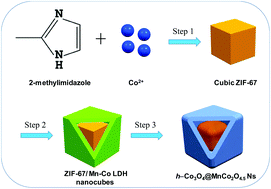Metal–organic framework-derived hierarchical Co3O4@MnCo2O4.5 nanocubes with enhanced electrocatalytic activity for Na–O2 batteries†
Abstract
The Na–O2 battery system is attracting increasing attention due to its superiority in specific capacity and cost. However, its practical implementation is hindered by many issues, such as high charge–discharge overpotential, limited cycling life, and poor reversibility, all of which result from the mediocre O2 electrode. Herein, to surmount these critical challenges, hierarchical Co3O4@MnCo2O4.5 nanocubes (h-Co3O4@MnCo2O4.5 Ns) with a yolk–shell structure are designed for the first time as the novel O2 electrode. h-Co3O4@MnCo2O4.5 Ns are synthesized from a metal–organic framework via a template-assisted method, which is demonstrated to be helpful in creating a high specific surface area of 130.4 m2 g−1, a hierarchical macro- and mesoporous structure, and synergistic yolk-shelled Co3O4@MnCo2O4.5 active sites. These unique structural properties endow h-Co3O4@MnCo2O4.5 Ns with remarkably enhanced electrocatalytic activity towards both the ORR and OER. The Na–O2 battery based on h-Co3O4@MnCo2O4.5 Ns displays an ultrahigh initial discharge capacity of 8400 mA h g−1, ultralow charge–discharge overpotential of 0.45 V, long cycling life of 135 cycles, and excellent rate capability.



 Please wait while we load your content...
Please wait while we load your content...